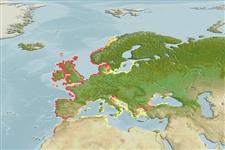Common names from other countries
Environment: milieu / climate zone / depth range / distribution range
Ecologia
; estuarina; intervalo de profundidade 3 - 14 m (Ref. 113231), usually 3 - 7 m (Ref. 105455). Subtropical; 69°N - 30°N, 11°W - 36°E
Northeast Atlantic and the Mediterranean: from Norwegian Sea and the Baltic, south to the Iberian Peninsula, into the Mediterranean, and along the Atlantic coast of Morocco.
Length at first maturity / Tamanho / Peso / Idade
Maturity: Lm ? range ? - ? cm Max length : 15.5 cm SHL macho/indeterminado; (Ref. 2758)
Minimum depth from Ref. 105455. It is a sessile-burrower, suspension feeder (Ref. 96498). Occurs in fine sand (Ref. 105213). In general, suspension feeding bivalves mainly depend on phytoplankton and detritus material for nutrition (Ref. 107088).
Life cycle and mating behavior
Maturidade | Reprodução | Desova | Ovos | Fecundidade | Larvas
Members of the class Bivalvia are mostly gonochoric, some are protandric hermaphrodites. Life cycle: Embryos develop into free-swimming trocophore larvae, succeeded by the bivalve veliger, resembling a miniature clam.
Tuck, I.D., N. Bailey, M. Harding, G. Sangster, T. Howell, N. Graham and M. Breen. 2000. (Ref. 2699)
Status na Lista Vermelha da IUCN (Ref. 130435)
Status no CITES (Ref. 108899)
Not Evaluated
Not Evaluated
Uso pelos humanos
Pescarias: espécies comerciais
| FishSource | Sea Around Us
Ferramentas
Fontes da internet
Estimates based on models
Preferred temperature
(Ref.
115969): 9 - 18.8, mean 11.4 (based on 555 cells).
Resiliência
Elevada, tempo mínimo de duplicação da população menor que 15 meses (K=0.7).
Vulnerabilidade
Low vulnerability (10 of 100).
Categoria de preço
Unknown.
